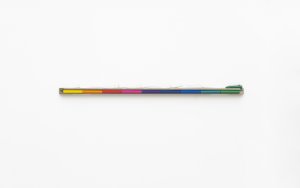Jac Leirner | Frieze
Jul 14 2023

At the Swiss Institute, New York, Jac Leirner’s sculptures and installations of discarded objects suggest the unseen exchanges of everyday life
Rooted in the meticulous collection and reappropriation of discarded objects, Jac Leirner’s practice traces the unseen contours of the everyday. In her survey exhibition currently on view at the Swiss Institute in New York, emery boards, pen caps and paper tickets line the walls of the ground floor gallery, arranged by colour on thin metal shelves. In the corners, handyman’s levels and notebook spines form ‘X’s like scaffold supports. Upstairs, newspaper ads, business cards and posters pulled from the streetlights of the Lower East Side are collaged on canvas. These are the objects that linger at the back of your desk drawer, the rarely used fold of your wallet or the centre console of your car. Not all the works successfully transcend the image of the artist as simply a serial collector, but those that do allude to the full complexity of interlaced allegiances – personal and political – that run electric through the grid of our day-to-day lives.
Curiously, Leirner speaks about her work as primarily a study in materiality. In a 2011 interview with Adele Nelson, she claimed to be motivated first and foremost by the physical quality of objects, choosing to combine them chiefly by happenstance. She links her practice back to Dada, to meaning in nonsense. And yet, despite her fascination with material, her best works trade more directly in the institutional afterlives of the objects than in their blunt physicality. Inspired by the constructivism of her native Brazil and the conceptual art of New York in the 1960s and ‘70s, the minimal profiles of Leirner’s works place her amongst a group of artists who, beginning in the 1990s, retooled minimalist aesthetics to hold poetic and political meaning. The detritus of daily life becomes not only a shadow representation of that life, but perhaps more crucially, a loose sketch of the systems and networks that validate it. Pens and pencils taken from research libraries, museums and opera houses lined tip to toe and suspended across the walls gesture at the artists, workers and visitors who both feed and rely on the institutional ecosystem.
This interdependent network is perhaps best exemplified by Nice to Meet You (2023). Installed along the back wall of the ground floor exhibition space, rows of business cards are fixed to two metal strips. The work is an extension of the artist’s series, ‘Foi um prazer’, which has seen a number of different iterations since its inception in 1987. A blend of new and old, the cards date themselves, listing editors for now-defunct magazines and gallery directors who’ve since opened their own, eponymous spaces. Wear is evidenced in folded corners, coffee stains and pencilled scribbles. Placed directly in front, on a low plinth, is Blue Phase (1992), a sculpture constructed of hundreds of Brazilian cruzeiro banknotes, punctured and stitched together to form an organic, circular shape.
In 1986, the new Brazilian cruzado was introduced at an exchange rate of 1 to 1000, rendering the cruzeiro the second currency to become useless following decades of runaway inflation. The direct correlation between the two works is evident: the cards, indicative of knowing and being known, operate as a currency traded within the various overlapping circuits of the artworld. The juxtaposition paints value itself as exceedingly fragile – produced not only through the organic reification of circuits, systems and ‘worlds,’ but capable also of being redirected or voided at the sudden whim of the state. Adjacent to institutional critique, Leirner’s strict attention to the minute in her art ultimately captures the overlapping value systems that pepper our daily engagement with life itself – not criticizing per se, but rather precisely illuminating the webs of exchange on which we all invariably depend.
